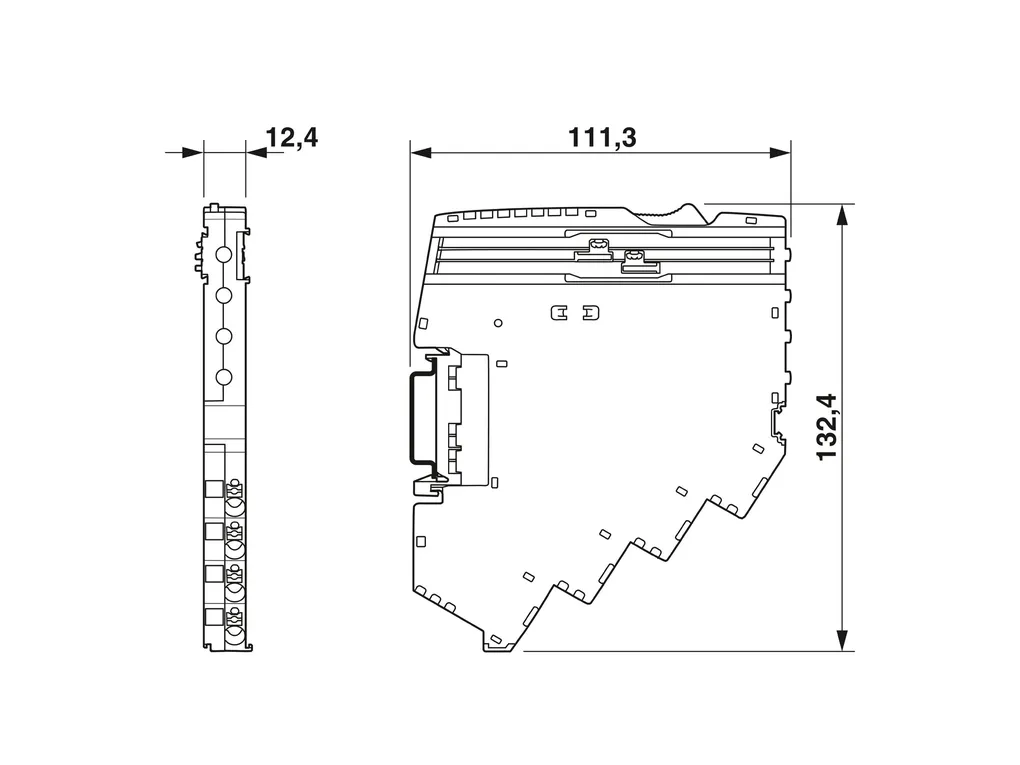Industrial Automation
 Not available
Not available 

 Not available
Not available | Notes | General Note: LABS release ââ¬Ã¢ in accordance with test specification VWÃPVÃ3.10.7:2005-0 When using CAPAROC E1... modules, for continuous shock in accordance with IEC 60068-2-27 the 6ÃmsÃ/Ã15g degree of severity applies |
| Product properties | Product type: Device circuit breakers Product family: CAPAROC Number of positions: 1 No. of channels: 4 Number of slots: 2 Insulation characteristics Protection class: III Pollution degree: 2 |
| Electrical properties | No. of channels: 4 General Operating voltage: 10 VÃDC ... 30 VÃDC Rated voltage: 12 VÃDC 24 VÃDC Rated current IN: 10 AÃDC (per channel) 1Ã/Ã2Ã/Ã3Ã/Ã4Ã/Ã5Ã/Ã6Ã/Ã7Ã/Ã8Ã/Ã9Ã/Ã10ÃAÃDCÃ(adjustable per output channel) Rated current (pre-adjusted): 4 A Rated surge voltage: 0.5 kV Tripping method: E (electronic) Feedback resistance: max. 35 VÃDC Switch-on delay: 50 ms (each channel preset by default) can be adapted with CAPAROC PMÃIOL and CAPAROC PMÃPN power modules Required backup fuse: Only required if Imax of the power supply > the short-circuit switching capacity. Integrated failsafe element. Short-circuit switching capacity: 300 A Dielectric strength: 35 VÃDC (Load circuit) Fuse: electronic Efficiency: > 99 % Closed circuit current I0: typ. 20 mA (no load at 24ÃV) Power dissipation: typ. 0.48 W (no load at 24ÃV) < 6 W (in nominal operation at 24ÃV and 10ÃA) Waiting time after switch off of a channel: 5 s (at overload / short circuit) Measuring tolerance I: ñ 10 % (typ.) Temperature derating: 16 A (Total current at 65ðC) 40 A (Total current atÃ25°C) MTBF (IEC 61709, SN 29500): 6325945.91 h (at 25ðC with 21Ã% load) 1812525.02 h (atÃ40°C with 34.25%Ãload) 365459.81 h (at 25°C with 100% load) Voltage drop: 0.14 V (at 10 A) Fail-safe element: 15 AÃDC (per output channel) Load circuit Shutdown time: 4 s (with overload 1.1â⬦1.5ÃxÃIN) 1 s (with overload 1.5â⬦2.0ÃxÃIN) 0.1 s (with overload 2.0â⬦3.0ÃxÃIN) ââ°¤ 10 ms (For short circuit > 3.0 x IN) Undervoltage switch-off: ââ°¤ 8.5 VÃDC (active) ââ°¥ 9.2 VÃDC (inactive) Overvoltage switch-off: ââ°¥ 32.5 VÃDC (active) ââ°¤ 30.5 VÃDC (inactive) Max. capacitive load: ââ°¤ 25000 õF (Depending on the current setting and the short-circuit current available) |
| Connection data | Fuse-protected output Connection method: Push-in connection Stripping length: 10 mm Conductor cross section flexible: 0.2 mm² ... 4 mm² Conductor cross section rigid: 0.2 mm² ... 4 mm² Conductor cross section AWG: 24 ... 12 Conductor cross section, flexible, with ferrule, with plastic sleeve: 0.25 mm² ... 4 mm² Conductor cross section flexible, with ferrule without plastic sleeve: 0.25 mm² ... 4 mm² |
| Signaling | Channel LED off: off (Channel switched off) Channel LED yellow: lit (Channel switched on, channel loadÃ>Ã80%Ã) flashing (Programming mode active) two flashes (Check the installation, no communication to power module) Channel LED green: lit (Channel switched on) Channel LED red: lit (Channel switched off, over- or undervoltage active) ON temporarily (Channel switched off, 5Ãs cool-down phase, overload or short-circuit release) flashing (Channel switched off, ready to be switched back on, overload or short-circuit release) two flashes (Channel switched off, system total current limit exceeded) Channel LED red-yellow: flashing (Channel switched on, overload mode, capacity approximately 110Ã...Ã150%,Ãshutdown after 5Ãs) Channel LED red-green: flashing (Channel switched off, programming mode active, current adjustment after overload or short-circuit release) |
| Dimensions | Dimensional drawing: https://dam-mdc.phoenixcontact.com/rendition/156443151564/84ad7270028ea44ea30c9bbb102dae1a/-S204x204-FJPG Width: 12.4 mm Height: 132.4 mm Depth: 111.3 mm (incl. DIN rail 7.5Ãmm) |
| Material specifications | Material: PA 6 PC Flammability rating according to UL 94: V-0 |
| Environmental and real-life conditions | Ambient conditions Degree of protection: IP20 Ambient temperature (operation): -30°C ... 65°C (The temperature range of the power module must be taken into consideration) Ambient temperature (storage/transport): -40°C ... 70°C Altitude: ââ°¤ 4000 m (amsl) Humidity test: 96Ãh, 95Ã%ÃRH, 40ðC Shock (operation): 30g (11 ms period, half-sine shock pulse, according to IEC 60068-2-27) 25g (6Ãms duration, half-sine shock pulse in accordance with IEC 60068-2-27, continuous shock) Vibration (operation): 5g (10 ... 150ÃHz / 10Ãcycles / axis / X,ÃY,ÃZ) |
| Approvals | UL approval Identification: UL/C-UL Listed UL 508 UL Recognized UL 2367 |
| Standards and regulations | Standards/specifications: ENÃ61000-6-2 ENÃ61000-6-3 ENÃ60068-2-78 ENÃ50178 ENÃ60068-2-6 ENÃ60068-2-27 Note: EMC ââ¬Ã¢ Immunity for industrial areas EMC ââ¬Ã¢ Emission for residential, business and commercial properties and small operations Environmental influences ââ¬Ã¢ Moisture and heat, constant Equipping power installations with electronic equipment Environmental influences ââ¬Ã¢ Vibrations (sinusoidal) Environmental influences ââ¬Ã¢ Shocks |
| Mounting | Mounting type: pluggable onto CAPAROC CRâ⬦ current rail |
Description other products
